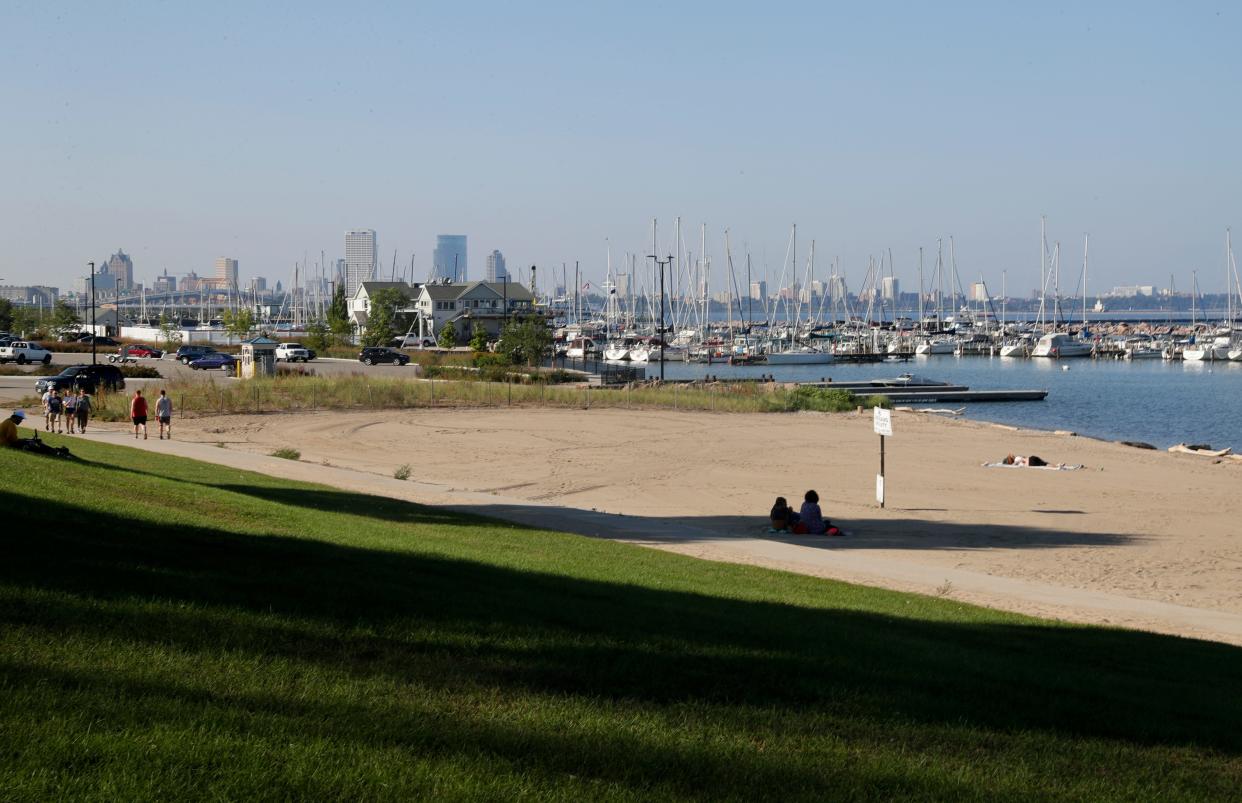Study finds persistent bacteria problems at U.S., Great Lakes beaches. We answer 6 key questions.

Going to the beach to soak up the sun and water is a hallmark of summers in the Great Lakes region. But according to a new study, your beach time is likely getting cut short by fecal bacteria.
A study from Environment America found persistent problems with bacteria pollution along U.S. and Great Lakes coastlines. Last year, there were more than 8,700 health warnings or closures at beaches along the nation's coastal beaches, interrupting one out of every 12 swimming days.
Across the Great Lakes, 63 percent of beaches tested were considered unsafe to swim in for at least one day. The nationwide average was 55 percent.
So, where do these fecal bacteria come from? How does Wisconsin fare compared to other Great Lakes states? And how many beach closures have there been in 2023 so far?
We answer six questions.
Where does beach pollution come from?
Swimming in water contaminated with fecal bacteria is a health hazard, potentially leading to gastrointestinal illness, respiratory disease, ear and eye infections and skin rash.
Bacteria pollution comes from stormwater runoff, sewage overflows and manure from industrial livestock production.
In rural areas, factory farms can lead to fecal pollution from livestock production entering waterways.
In more urban areas, sprawling development is creating more impervious surfaces, like parking lots and roads, that increase runoff during heavy rains. Outdated and deteriorating sewage systems, like combined sewers, also are a problem because raw sewage can lead to more bacteria entering the water.
Milwaukee has a combined sewer system that combines stormwater and sewage into a single pipe. Heavy rain events can lead to overflows where untreated sewage is discharged into nearby waterways that lead to Lake Michigan.
There were two major overflows in the last year during historic rainfall events in February this year and last September. By federal law, Milwaukee’s sewerage district is allowed six overflows per year.
How does Wisconsin compare to other Great Lakes states?
Across Wisconsin’s Great Lakes shorelines, 67 percent of beaches were unsafe for at least one day last summer, according to the study.
The state fell in the middle compared to the other seven Great Lakes states.
Lake Erie beaches fared the worst. All of the beaches tested in Pennsylvania and 96 percent of the beaches in Ohio had at least one unsafe swimming day last year.
Lake Michigan shorelines in Illinois and Indiana also had high percentages with 95 and 83 percent, respectively.
Along New York’s Lake Ontario shoreline 58 percent of testing days had unsafe bacteria levels.
Minnesota and Michigan had the lowest percentages with 34 and 43 percent, respectively.
What beaches were the most unsafe to swim in Wisconsin?
The study looked at 113 beaches in Wisconsin along the shores of Lakes Superior and Michigan.
Kewaunee County had the highest percentage of days unsafe for swimming compared to any other county in the state.
As for specific beaches, unsafe levels of fecal bacteria were found 27 days last summer at Milwaukee County’s South Shore beach – more than any other in the state.
Other notable beaches with a high percentage of unsafe swimming days included:
Fischer Park in Manitowoc County with 44 percent.
Otumba Park Beach in Door County with 46 percent;
Crescent Beach in Kewaunee County with 40 percent; and
Lakefront Park Beach in Manitowoc County with 39 percent.
What’s going on this year?
The Wisconsin Department of Natural Resources monitors 108 Great Lake beaches from Memorial Day to Labor Day weekends.
Since the start of the season, 15 beaches have closed at some point due to high bacteria levels as of July 6, according to the DNR.
So far, all closures have been along Lake Michigan shorelines.
There have also been 36 beach advisories, meaning swim at your own risk. All but one, in Bayfield County, have been on Lake Michigan.
How can we prevent beach pollution?
Protecting and restoring wetlands will ensure that they can continue to absorb floodwaters and filter out pollutants before they enter larger waterways like the Great Lakes.
Wisconsin has already lost the vast majority of its wetlands, but has strict protections for the ones that remain. But a recent Supreme Court decision dialed back protections, so wetlands across the Great Lakes may be at risk.
Building green infrastructure, like rain barrels, permeable pavement and green space, in cities can help soak up rainfall during heaving rain events, leading to less runoff.
Milwaukee's sewerage district is working on projects to restore habitat along waterways and create more green infrastructure that helps soak up more rainfall.
Encouraging rotational grazing, enacting moratoriums on industrial livestock farms and creating policies to stop manure from flowing into waterways can help prevent beach closures in rural areas.
Where can I learn more about beach closures?
In Wisconsin, current beach advisories and closures are listed on the DNR website. Water conditions can change quickly, so the DNR suggests paying attention to posted signs at local beaches for the most up-to-date information.More detailed information on water quality, testing and beach closings from previous seasons can be found on the EPA’s beach advisory website.
Caitlin Looby is a Report for America corps member who writes about the environment and the Great Lakes. Reach her at clooby@gannett.com or follow her on Twitter @caitlooby.
Please consider supporting journalism that informs our democracy with a tax-deductible gift to this reporting effort at jsonline.com/RFA or by check made out to The GroundTruth Project with subject line Report for America Milwaukee Journal Sentinel Campaign. Address: The GroundTruth Project, Lockbox Services, 9450 SW Gemini Dr, PMB 46837, Beaverton, Oregon 97008-7105.
This article originally appeared on Milwaukee Journal Sentinel: U.S., Great Lakes beaches have persistent bacteria problems

